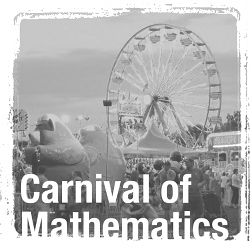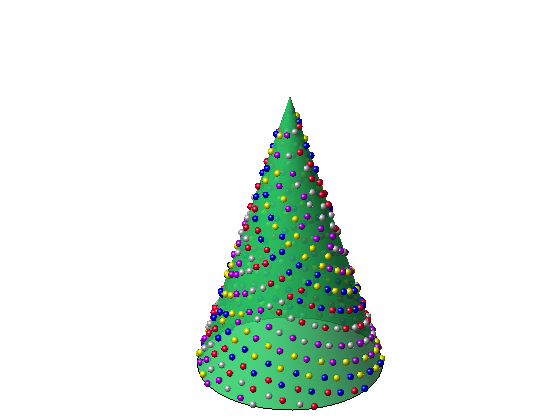 Welcome to the 94th Carnival of Mathematics! This month the carnival has once again trundled in to Blackboard Bold at the Aperiodical, though this time with myself rather than Katie at the helm (carnivals have helms).
Welcome to the 94th Carnival of Mathematics! This month the carnival has once again trundled in to Blackboard Bold at the Aperiodical, though this time with myself rather than Katie at the helm (carnivals have helms).
Since it is no longer Christmas, I thought it would be good to start with a couple of Christmassy posts. First off, Win Smith writes on his blog The Well-Tempered Spreadsheet about the age-old problem of how to arrange your Christmas tree decorations. Doubtless you as well as I have fallen into the trap of deciding to put one last ornament on the tree to fill that one last big gap, only to find that the new addition has altered the average gap-area, creating a new unsightly largest festive void, in which you decide to put one last bauble, and so on. Well worry no longer, as you can now apply Win’s quasi-random placement algorithm to ensure your trinkets will be pleasingly distributed over the branches, even if you don’t know when starting to decorate how many items you have available to place.
Now unless you plan to use calculation-friendly massless point-baubles, you’ll want some mathematical decorations to festoon the quasi-random locations. matheminutes has rhombic-dodecahedron 12 Days of Christmas baubles, fractal snowflakes, Mobuis paper chains and an excellent star made of five intersecting tetrahedra. An unfortunate choice of photo angle means the picture of the dodecahedron looks like it’s just a cube, so be sure to look at the full-size picture of the tree at the top of the post to get the right idea.
Time for a bit of audience participation: help Mr Honner come up with a definition of equilateralness, and work out how Colin’s shortcut for computing the fraction representation of a recurring decimal works at Flying Colours Maths.
(If you’ve sorted those two out, I suggest reading this piece from the Boston Globe ‘Ideas’ blog introducing the ABC-conjecture and its potential solution, and get cracking on verifying the proof.)
Statistics! Peter Norvig, director of research at Google (with whom you may be familiar) responds to a letter from an 85-year-old researcher who worked on letter frequencies in natural-use English in the 1960s. Peter revisits this topic with the might of Google’s colossal corpus of English text, and in doing so overturns a piece of conventional wisdom known as ETAOIN SHRDLU (with which you would be forgiven for not being familiar). For a real-world application of this sort of analysis, I suggest you read the dissection of the optimal Hangman strategy at DataGenetics.
Fans of preposterously-elaborate page headers should head straight over to Steven Wittens’ blog at Acko.net. The rest of you should too because beneath is a brilliant explanation of Julia and Mandelbrot sets, furnished with excellent animations to get the ideas across.
Math Mama (Sue VanHattum) advocates the principle of learning-by-explaining, with an introduction to everyone’s third-favourite sort of centre of a triangle, the centroid. Read it and understand this elusive notion (though not as well if you had written it. Perhaps you could teach yourself about the orthocentre by writing a blog to explain it, and be featured in the Carnival of Mathematics 95).
We shall finish with a couple of posts from the much-loved maths/art interface: 225pi.com has created a musical interpretation of the first 225 digits of $\pi$ (that is, a piece of music, rather than a stage musical, more’s the pity); and Maxwell’s Demon gives a taster of braid theory by way of its applications to wedding ring design.
That’s all for this carnival! CoM ’95 will be hosted by Jorge at MathFact (don’t worry, in English).

Nice collection. Too bad I forgot to submit my entry.
There’s always next month!
Thank you for the mention! I am pleased to see my work included here.
If anyone is interested, animations of quasi-random trees can be found at
http://welltemperedspreadsheet.wordpress.com/2012/12/26/quasi-random-christmas-trees-at-the-movies/
Hi.
The link to website 225pi.com is broken.
Thanks
DF